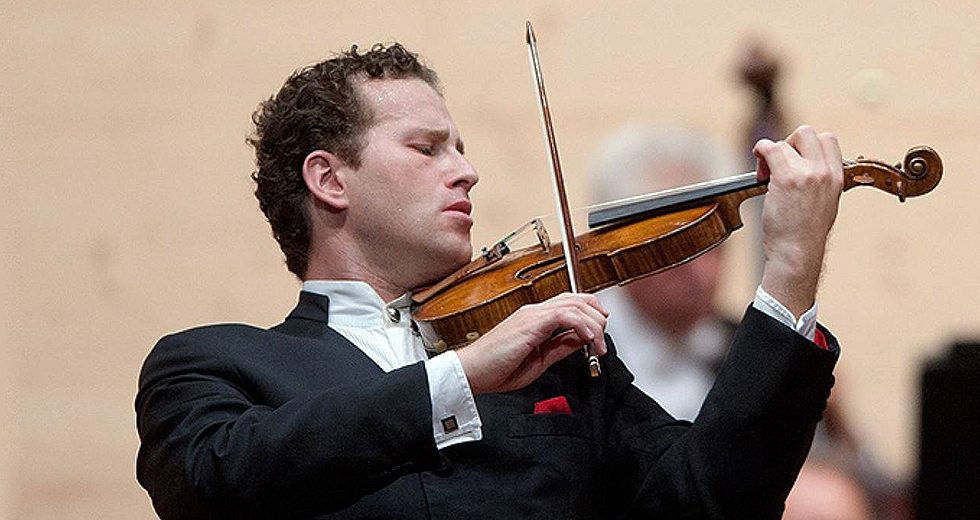
Sometimes Nikolaj Znaider performs violin concertos with many of the world’s most prestigious orchestras, and sometimes he conducts. But rarely does he undertake both tasks simultaneously, because of the hurdles such a dual role presents.
When pianists conduct from the keyboard, the piano is set up perpendicular to the stage. Soloists sit with their backs to the audience but their hands are readily visible to the musicians. However, a violin soloist has to stand for much of the time with his or her back to the orchestra. While that’s good for the audience, it can be tough for the performer to communicate with the musicians at the same time.
“So it’s something that I don’t really do,” Znaider, 42, said from France, where he was in rehearsals for concerts with the Orchestre National de Lyon, one of that country’s best ensembles.
But he does make occasional exceptions, as he will Dec. 21-23, when he makes his subscription debut with the Chicago Symphony Orchestra as a conductor. (He has previously joined the CSO as a violin soloist many times.) He will lead a program with two of the most frequently performed works in the orchestral repertoire: Beethoven’s Violin Concerto and Shostakovich’s Symphony No. 5.
“It’s not only a great orchestra, but it’s an orchestra that I have a lot of history with in a way,” he said of the CSO. He recalls playing regularly with the ensemble during the last seven years or so of Daniel Barenboim’s tenure, and in part because he has family in Chicago, he also occasionally attended CSO concerts as well. “So I was around a lot in those years,” he said. “I have a lot of good memories from Chicago.”
Znaider is pleased with the pairing of works on his latest CSO engagement. Earlier in his career, he collaborated with famed Russian violist and conductor Rudolf Barshai. Znaider was supposed to play the Beethoven Violin Concerto, but he wanted to change the selection to something else. Barshai insisted on keeping the work, because the second half featured a symphony by Shostakovich.
The violinist recalls the conductor saying: “The reason why you have to do Beethoven is because Shostakovich, and [Barshai] knew Shostakovich, always said that his symphonies should be played with Classical repertoire. This stayed with me somehow. It’s true that the contrasts between the works couldn’t be starker, and yet they go together very well.”
Born in Denmark to Israeli parents, Znaider first gained recognition in 1992, when he won first prize at the Carl Nielsen International Music Competition 1992. He topped that victory five years later by winning the better-known Queen Elisabeth Competition in Brussels. As he followed up those successes with further study with famed pedagogue Dorothy DeLay at the Juilliard School, he began performing with major orchestras worldwide and his professional career was quickly launched.
Later, he began to conduct. “I conduct for the reason I play the violin, because I love music,” he said. “My path happened to be that I started playing the violin and I ended up taking it to a high level maybe, but quite early on, I realized that I wanted to conduct. It was a matter of finding the chance, the time and the opportunity to start.”
As he done more of both, Znaider has discovered that his conducting feeds his violin performance. “The depth of my musicianship, what I can bring to the Beethoven Violin Concerto, is only enhanced and enriched by the symphonies that I occupy myself with as a conductor,” he said. “It’s something that goes absolutely in tandem.”
On those occasions when Znaider conducts from the violin, it’s almost always while playing the Mozart violin concertos or the Beethoven Concerto, Classical-era works that typically call for smaller forces. The dual role of violinist-conductor is most often seen is in the Baroque world with noted performers like Andrew Manze. “The forces are smaller, and there are simply fewer people involved, so it really doesn’t really become a practical issue,” Znaider said. “There isn’t that much sound, and the violinist isn’t drowned out having his back turned to the orchestra. It’s a much different thing.”
He recently recorded all five of Mozart’s violin concertos with the London Symphony Orchestra. An album of Concertos Nos. 4-5 is scheduled for release in March. Znaider made his debut as a violinist with the LSO in 2006, and his conducting premiere came five years later. His close connection to the LSO developed in part because of his ties to Colin Davis, the orchestra’s principal conductor from 1995 through 2006 and later its president.
“It became a kind of instant chemical eruption,” he said of their first collaborations. “Then, we played an awful lot together, tours and recordings. Everywhere he went, I went with him for the last seven or eight years of his life. It became a very special relationship.” Davis was to have conducted the Mozart concerto project, and after he died 2013, Znaider and the LSO decided to proceed with the project as an homage to Davis.
Since 2011, Znaider has served as principal guest conductor of the celebrated Mariinsky Orchestra in St. Petersburg, Russia, a position that has allowed him to conduct both symphonic concerts and operatic productions. Someday, he hopes to have his first music directorship somewhere. “Absolutely, when the right thing comes,” he said. “The next logical step is, of course, to have an orchestra with whom I can have a deeper connection and a more regular role.”
But for now, he is happy to make great music wherever he might be, and for this week in December, it will be Chicago: “It will be a real treat to end the year like this.”